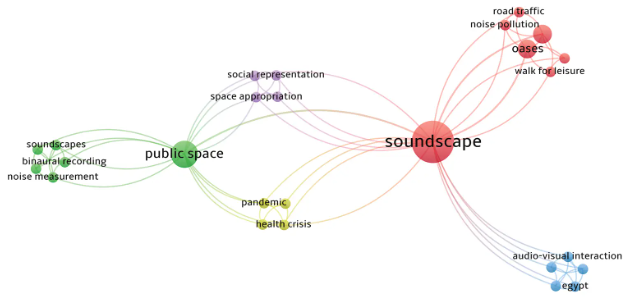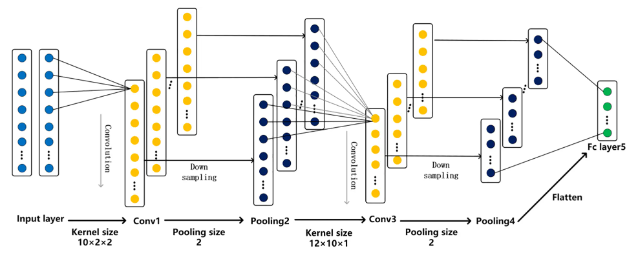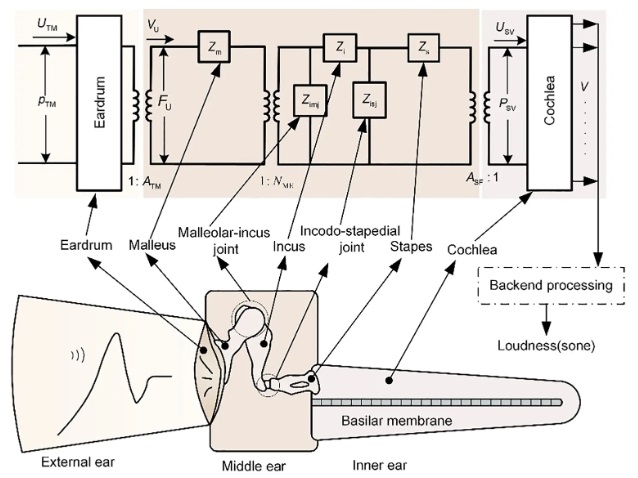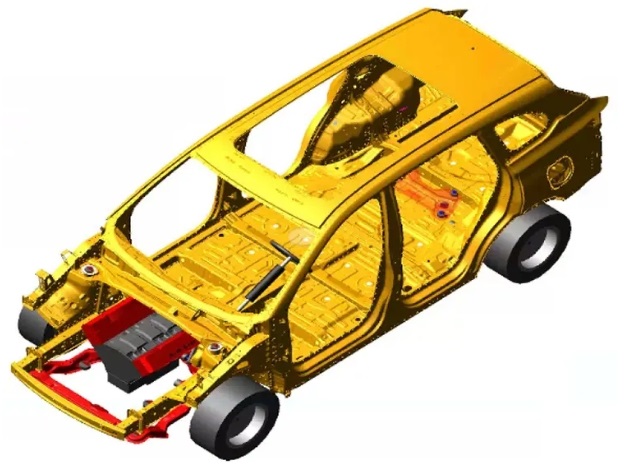Experimental and theoretical analysis of nonlinear acoustic characteristics of perforated acoustic liners
Abstract
Perforated acoustic liner is one of the key components commonly used to suppress combustion oscillation in afterburners of military aircraft engines. The acoustic pressure generated by combustion oscillation is relatively high, and the nonlinear characteristics of these liners are significant. This paper employs both experimental and theoretical methods to study the nonlinear absorption coefficient and acoustic impedance of perforated acoustic liners in the range of 0 to 200 Pa. The results indicate that nonlinear effects increase the primary absorption frequency up to 70 Hz as the acoustic pressure amplitude rises from 2 Pa to 200 Pa. For small acoustic pressure amplitudes, it is recommended to use acoustic liners with smaller perforations, whereas for larger amplitudes, the perforation diameter should be increased (d > 4 mm). For liners with a perforation diameter of 1.1 mm, the inclination angle has little effect on the absorption coefficient. When the acoustic pressure amplitude is small, the acoustic liner has an optimal backing cavity height. However, at larger acoustic pressure amplitudes (200 Pa), increasing the backing cavity height is beneficial for the absorption coefficient. When the backing cavity height increased from 20 mm to 130mm, the absorption coefficient more than doubled. The nonlinear acoustic characteristics of perforated acoustic liners can provide valuable insights for the design of anti-vibration screens in afterburners.
References
[1]Smith G, Henderson R. Combustion instability in a turbofan mixed-flow augmentor. In: Proceedings of 8th Joint Propulsion Specialist Conference; 1972; New Orleans, LA, USA.
[2]Yu Z, Xu Y. Analysis of Thermoacoustic Instabilities Using the Helmholtz Method in a Swirled Premixed Combustor. Processes. 2024; 12(4): 741. doi: 10.3390/pr12040741
[3]Cheng J, Liu B, Zhu T. Characterizing combustion instability in non-premixed methane combustion using internal flue gas recirculation. Applied Energy. 2024; 370: 123602. doi: 10.1016/j.apenergy.2024.123602
[4]Wei D, Fang H, Zhou H. Investigation on self-excited thermoacoustic instability and emission characteristics of premixed CH4/NH3/air flame. Thermal Science and Engineering Progress. 2024; 51: 102614. doi: 10.1016/j.tsep.2024.102614
[5]Kim S, Kim D. Analytical modeling of thermoacoustic instability influences in gas turbine combustors: A detailed parameter sensitivity analysis. Case Studies in Thermal Engineering. 2024; 59: 104595. doi: 10.1016/j.csite.2024.104595
[6]Shi X, Zhang J, Zhang Y, et al. Combustion and extinction characteristics of an ethanol pool fire perturbed by low–frequency acoustic waves. Case Studies in Thermal Engineering. 2024; 60: 104829. doi: 10.1016/j.csite.2024.104829
[7]Yu M, Jiang G, Jiang Y, et al. Experimental and numerical study of convective heat transfer in-line tube bundle by acoustic action. Case Studies in Thermal Engineering. 2023; 44: 102869. doi: 10.1016/j.csite.2023.102869
[8]Noiray N, Schuermans B. Theoretical and experimental investigations on damper performance for suppression of thermoacoustic oscillations. Journal of Sound and Vibration. 2012; 331(12): 2753-2763. doi: 10.1016/j.jsv.2012.02.005
[9]Kelsall G, Troger C. Prediction and control of combustion instabilities in industrial gas turbines. Applied Thermal Engineering. 2004; 24(11-12): 1571-1582. doi: 10.1016/j.applthermaleng.2003.10.025
[10]Bourquard C, Noiray N. Stabilization of acoustic modes using Helmholtz and Quarter-Wave resonators tuned at exceptional points. Journal of Sound and Vibration. 2019; 445: 288-307. doi: 10.1016/j.jsv.2018.12.011
[11]Pandalai R, Mongia H. Combustion instability characteristics of industrial engine dry low emission combustion systems. In: Proceedings of 34th AIAA/ASME/SAE/ASEE Joint Propulsion Conference and Exhibit; 13–15 July 1998; Cleveland, OH, USA.
[12]Zhao D, Ji C, Wang B. Geometric shapes effect of in-duct perforated orifices on aeroacoustics damping performances at low Helmholtz and Strouhal number. The Journal of the Acoustical Society of America. 2019; 145(4): 2126-2137. doi: 10.1121/1.5096642
[13]Kim D, Jung S, Park H. Acoustic damping characterization of a double-perforated liner in an aero-engine combustor. Journal of Mechanical Science and Technology. 2019; 33(6): 2957-2965. doi: 10.1007/s12206-019-0544-2
[14]Zhou H, Meng S, Tao C, et al. Low-frequency sound absorptive properties of dual perforated plates under bias flow. Applied Acoustics. 2019; 146: 420-428. doi: 10.1016/j.apacoust.2018.11.027
[15]Jing X, Sun X. Effect of Plate Thickness on Impedance of Perforated Plates with Bias Flow. AIAA Journal. 2000; 38(9): 1573-1578. doi: 10.2514/2.1139
[16]Wu G, Lu Z, Xu X, et al. Numerical investigation of aeroacoustics damping performance of a Helmholtz resonator: Effects of geometry, grazing and bias flow. Aerospace Science and Technology. 2019; 86: 191-203. doi: 10.1016/j.ast.2019.01.007
[17]Wu G, Guan YH, Ji C, et al. Experimental studies on sound absorption coefficients of perforated pipes with bias-grazing flows at low Mach and Strouhal number. Aerospace Science and Technology. 2020; 107: 106255. doi: 10.1016/j.ast.2020.106255
[18]Yu Z, Yang Y. Investigation of thermoacoustic oscillation attenuation by modified Helmholtz dampers with dual frequency bands. Applied Acoustics. 2022; 185: 108433. doi: 10.1016/j.apacoust.2021.108433
[19]von Saldern JGR, Eck MEG, Beuth JP, et al. Acoustic characteristics of impingement cooling sheets; effect of bias-grazing flow interaction on the liner impedance in a thin annulus. Journal of Sound and Vibration. 2022; 527: 116818. doi: 10.1016/j.jsv.2022.116818
[20]SheikhMozafari MJ. Enhancing Sound Absorption in Micro-Perforated Panel and Porous Material Composite in Low Frequencies: A Numerical Study Using FEM. Sound & Vibration. 2024; 58(1): 81-100. doi: 10.32604/sv.2024.048897
[21]Sekar V, Yong Eh Noum S, Putra A, et al. Acoustic Properties of Micro-Perforated Panels Made from Oil Palm Empty Fruit Bunch Fiber Reinforced Polylactic Acid. Sound&Vibration. 2021; 55(4): 343-352. doi: 10.32604/sv.2021.014916
[22]Ghanadi F, Arjomandi M, Cazzolato B, et al. Interaction of a flow-excited Helmholtz resonator with a grazing turbulent boundary layer. Experimental Thermal and Fluid Science. 2014; 58: 80-92. doi: 10.1016/j.expthermflusci.2014.06.016
[23]Tam C, Kurbatskii K, Ahuja K, et al. R. A numerical and experimental investigation of the dissipation mechanisms of resonant acoustic liners. In: Proceedings of 7th AIAA/CEAS Aeroacoustics Conference and Exhibit; 28–30 May 2001; Maastricht,Netherlands.
[24]Cummings A. Acoustic nonlinearities and power losses at orifices. AIAA Journal. 1984; 22(6): 786-792. doi: 10.2514/3.8680
[25]Ji C, Zhao D. Two-dimensional lattice Boltzmann investigation of sound absorption of perforated orifices with different geometric shapes. Aerospace Science and Technology. 2014; 39: 40-47. doi: 10.1016/j.ast.2014.08.010
[26]Zhu J, Qu Y, Gao H, et al. Nonlinear sound absorption of Helmholtz resonators with serrated necks under high-amplitude sound wave excitation. Journal of Sound and Vibration. 2022; 537: 117197. doi: 10.1016/j.jsv.2022.117197
[27]Singh DK, Rienstra SW. Nonlinear asymptotic impedance model for a Helmholtz resonator liner. Journal of Sound and Vibration. 2014; 333(15): 3536-3549. doi: 10.1016/j.jsv.2014.03.013
[28]Zhang Z, Zhao D, Han N, et al. Control of combustion instability with a tunable Helmholtz resonator. Aerospace Science and Technology. 2015; 41: 55-62. doi: 10.1016/j.ast.2014.12.011
[29]Li L, Guo Z, Zhang C, Sun X. A Passive Method to Control Combustion Instabilities with Perforated Liner. Chinese journal of aeronautics. 2010; 23: 623-630. doi: 10.1016/S1000-9361(09)60263-6
[30]Meng S, Zhang M, Gao Y. Influence of the Acoustic Liner in Large Eddy Simulation of Longitudinal Thermoacoustic Instability in a Model Annular Combustor. Journal of Thermal Science. 2024; 33(2): 710-724. doi: 10.1007/s11630-024-1928-x
[31]Gullaud E, Nicoud F. Effect of Perforated Plates on the Acoustics of Annular Combustors. AIAA Journal. 2012; 50(12): 2629-2642. doi: 10.2514/1.j050716
[32]Howe MS. On the theory of unsteady high Reynolds number flow through a circular aperture. The Royal Society of London a Mathematical and Physical Sciences. 1979; 366(1725): 205-223. doi: 10.1098/rspa.1979.0048
[33]Meng S, Zhou H, Cen K. Application of the Perforated Plate in Passive Control of the Nonpremixed Swirl Combustion Instability Under Acoustic Excitation. Journal of Engineering for Gas Turbines and Power. 2019; 141(9). doi: 10.1115/1.4043848
[34]Deshmukh NN, Kudachi B, Joy S, et al. Suppression of Thermo-Acoustic Instabilities using Helhmoltz Resonator. In: Proceedings of 2019 International Conference on Nascent Technologies in Engineering (ICNTE); 4-5 January 2019; Navi Mumbai, India.
[35]Zalluhoglu U, Olgac N. A study of Helmholtz resonators to stabilize thermoacoustically driven pressure oscillations. The Journal of the Acoustical Society of America. 2016; 139(4): 1962-1973. doi: 10.1121/1.4946042
[36]Betz M, Zahn M, Hirsch C, et al. Impact of Damper Placement on the Stability Margin of an Annular Combustor Test Rig. In: Proceedings of Volume 4A: Combustion, Fuels, and Emissions; 17-21 June 2019; Arizona, USA.
[37]Aguilar JG, Dawson JR, Schuller T, et al. Locking of azimuthal modes by breaking the symmetry in annular combustors. Combustion and Flame. 2021; 234: 111639. doi: 10.1016/j.combustflame.2021.111639
[38]Doria A. A Simple Method for The Analysis of Deep Cavity and Long Neck Acoustic Resonators. Journal of Sound and Vibration. 2000; 232(4): 823-833. doi: 10.1006/jsvi.1999.2763
[39]Mohring J. Helmholtz resonators with large aperture. Acta Acustica united with Acustica. 1999; 85(6): 751-763.
[40]Crandall LB. Theory of Vibrating Systems and Sound. Nature. 1927; 120(3024): 544-544. doi: 10.1038/120544b0
Copyright (c) 2024 Yunpeng Liu, Peng Guo, Yibo Wang, Yingwen Yan

This work is licensed under a Creative Commons Attribution 4.0 International License.









